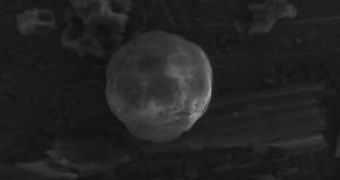Carbon beads only 50 micrometers across, known to scientists as carbon cenospheres, can only be formed while intensely heating coal or heavy fuel. A previous theory suggested that similar features were created by plant matter burning during a massive fire that raged across Earth some 65 million years ago, at the time the dinosaurs were extinct, but it was later demonstrated that carbon cenospheres cannot be formed during such a process. A new theory proposes that an asteroid impact created these beads and, if found to be true, it could reveal that the environmental conditions leading to the death of the dinosaurs were in fact not that severe as previously thought.
"Carbon embedded in the rocks was vaporized by the impact, eventually forming new carbon structures in the atmosphere", says co-author of the study, Indiana University Bloomington geologist Simon Brassell.
Carbon beads were found on top of the thin iridium layer deposited nearly 65 million years ago probably by an asteroid impact since asteroids have relatively high contents of iridium. The same iridium layer appears to be present in multiple locations around the globe, including Canada, Spain and New Zealand and is often accompanied by the carbon cenosphere deposit.
However, carbon cenospheres are often associated with the industrial era of our civilization, especially with the burning of coal and petrol. "Carbon cenospheres are a classic indicator of industrial activity. The first appearance of the carbon cenospheres defines the onset of the industrial revolution", says leader of the study Mark Harvey. Therefore there must be another process through which carbon cenospheres can be produced.
The team believes that 65 million year old cenospheres could have been created during a violent impact that pulverized the Earth's carbon-rich crust. Because the size of the carbon cenospheres is in direct relation to the vicinity of the Chicxulub Crater in the Yucatan peninsula the investigation team was led to believe that these have been created during the matter ejection following the impact. Larger and heavier particles would have fallen back to Earth much faster than the lighter particles, which traveled longer distances before setting on the ground.
It was estimated that the total mass of carbon cenospheres created and spread around the world in the outcome of the asteroid impact would have been close to 900 quadrillion kilograms, although how widely spread the carbon cenosphere distribution was remains mostly unknown and requires further investigation. "There are still clues to unravel about the events occurring around the time of the impact. And there are aspects of the Earth's natural carbon cycle that we didn't previously consider", said Brassell.
Harvey on the other hand seems to be more interested in the properties of these carbon beads. "Perhaps we can generate and study carbon cenospheres to better understand them. We also need to look for the cenospheres in other parts of the world and also around the time of other extinction events", he said.

 14 DAY TRIAL //
14 DAY TRIAL //